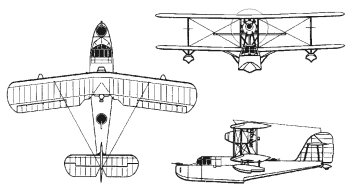



Designed by the same man behind the legendary Spitfire, R. J. Mitchell, the Supermarine Walrus (nicknamed "Shagbat") was a largely unsung single-engine biplane amphibian which found itself used extensively in almost every front during the war by the RAF and Fleet Air Arm. The Walrus was developed at the request of Australia, originally as a variant of the earlier Seagull although it was in reality a completely new aircraft, it ended up serving as a shipborne observation aircraft used mostly as a fleet spotter as well as for convoy patrol missions and anti-submarine duties on board Royal Navy cruisers and battleships as well as other Commonwealth warships. In RAF service, it was used mostly for search and rescue operations and was responsible for saving thousands of pilots around Britain and in the Mediterranean although they were also deployed worlwide in a range of bases in the Atlantic, North Africa, and the Middle East.
First flight of what was then known as the Seagull Mk. V took place on 21 June 1933 with deliveries to Australia beginning two years later. Evaluation by the British Ministry of Defense resulted in its adoption for local service as the Walrus Mk. I. Although these aircraft were all-metal, a variant constructed with a wooden hull was ordered by Australia as the Walrus Mk. II where it was known by that same name.
Preceded by:
NoneSucceeded by:
None | |
| Design | Walrus Mk. II |
| Type | Reconnaissance |
| Year | 1939 |
| Crew | 4 |
| Dimensions | |
| Length | 11.46 m |
| Height | 4.648 m |
| Wing Span | 13.97 m |
| Wing Area | n/a |
| Weight | |
| Empty | 2,223 kg |
| Maximum | 3,266 kg |
| Wing Loading | 57.6 kg/m² |
| Performance | |
| Speed | 200 km/h |
| Ceiling | 5,639 m |
| Range | 966 km |
| Powerplant | |
| Engine | 1 x Pegasus VI Bristol 578 kW |
| Thrust/Weight | 0.32 |
| Armament | |
| Guns | 2 x .303-inBrowning Mk. II |
| Payload | 227 kg |
| Production | |
| Built | 191 |
| Total | 771 |